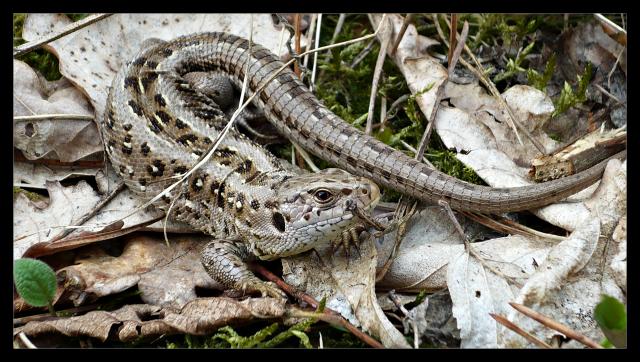Scientific Classification
Kingdom: Animalia
Phylum: Chordata
Class: Reptilia
Order: Squamata
Suborder: Lacertilia
Family: Lacertidae
Genus: Lacerta
Species: L. agilis
Distribution and habitat
Most common lizard species of Hungary. Its incidence in Europe is wide-ranging, it distributes from Sweden, Finland and South England, and extends through the territory of Asia (Asia Minor), from the Pyrenees to Northwest China. It is not present in southern Greece, southern and western France, a large part of Italy, Norway and most of the Iberian Peninsula.
The sand lizard is rather unassuming viewing its habitat and other ecological conditions. It is present on roadsides, in forests, on railway embankments. It likes grassy, humid and sunny slopes and open grasslands with few arboreal plants. It is present on plane, hilly and mountainous landscapes of Hungary, but it weathers the season from October to March in frost-free burrows, under stones, in logs. It can be found in these places in the nights of the following active periods as well.
Morphology, build-up
Its length is 20-24 cm, in some cases can reach 27 cm. It is stout, small-legged with wide-domed head and blunt toe. It has long and thick tail flattened at the base - the the tail of the female ones is shorter. The male and female can be clearly distinguished based on their coloration and patterns. The males’ side is grassgreen in breeding seasons and dark green in other seasons and have grayish-brownish stripe on the back, which are decorated with white spots. There are some sand lizard species that have large red-brown, orange, or greyish-brownish bar on the back instead. Its abdomen side is porcelain-green with black spots. The female is completely missing the the green color on its back. The abdomen side is bright yellow, pale cream-colored or white. There is a clear difference in the tincture of the older and younger ones. The younger specimens are brown.
Nutrition
Its food are soft-bodied animals, arthropods (spiders, butterflies, locusts, beetles, centipedes, bees, wasps, bugs) and often eats smaller lizards. It is a very useful insectivore.
Habits
It is active in early mornings, both in nutrition and reproduction activities. Likes to sunbathe, but does not like the blazing sun. In addition, it can bear the temperature fluctuations relatively well. Can be often found together with other lizard species.
Reproduction
The breeding season is in May, when the males fight each other. 5-6 weeks later the female hides its soft-shelled eggs in the grass, under stones, and covers its 8 to 12 eggs for to keep them warm. The hatching time depends on the temperature, but it is usually 2 months, so at the turn of July-August the young specimens start their individual lives.
Role in the ecosystem
Insectivorous creature. It is the main food of smooth snakes, hedgehogs, birds, buzzards, and domestic cats.
Role in the soil
Places its eggs in the soil, under the ground, thus ensuring the right temperature for race preservation.
Endangerment
It is not in direct danger, but the population is significantly reduced due to prevalent use of pesticides, significant and extreme weather changes and habitat fragmentation. In Hungary, all reptiles and amphibians are protected! Its goodwill value is 10 000 forints.
Exploitation by humans
Effective insectivorous. Many agricultural pests serve as food source for it.
http://fireiris.wordpress.com/2010/01/18/lacerta-agilis-furge-gyik-2/
http://www.tiszato.hu/allatvilag/furgegyik
http://www.orszagalbum.hu/kep.php?p=41720
http://www.berze-nagy.sulinet.hu/tanos/allatok/furgyik.htm
